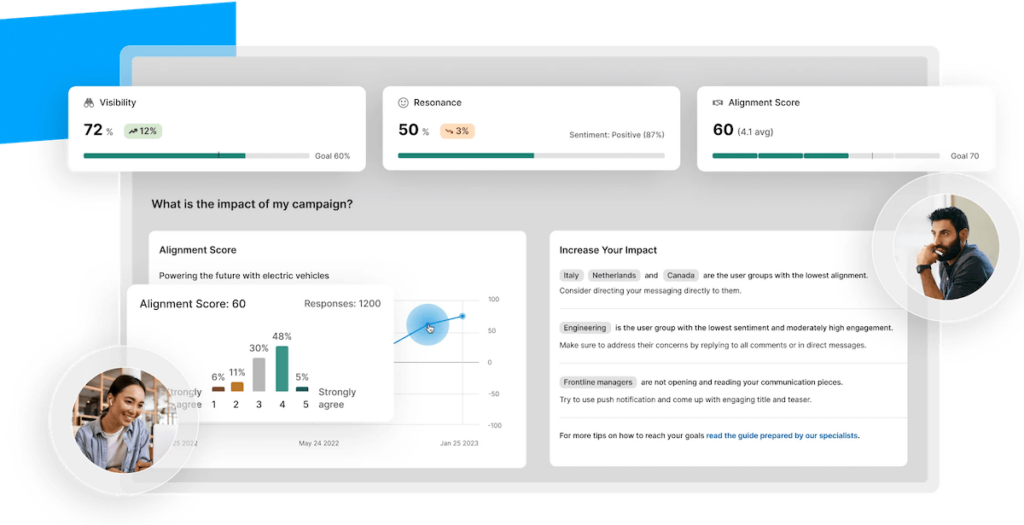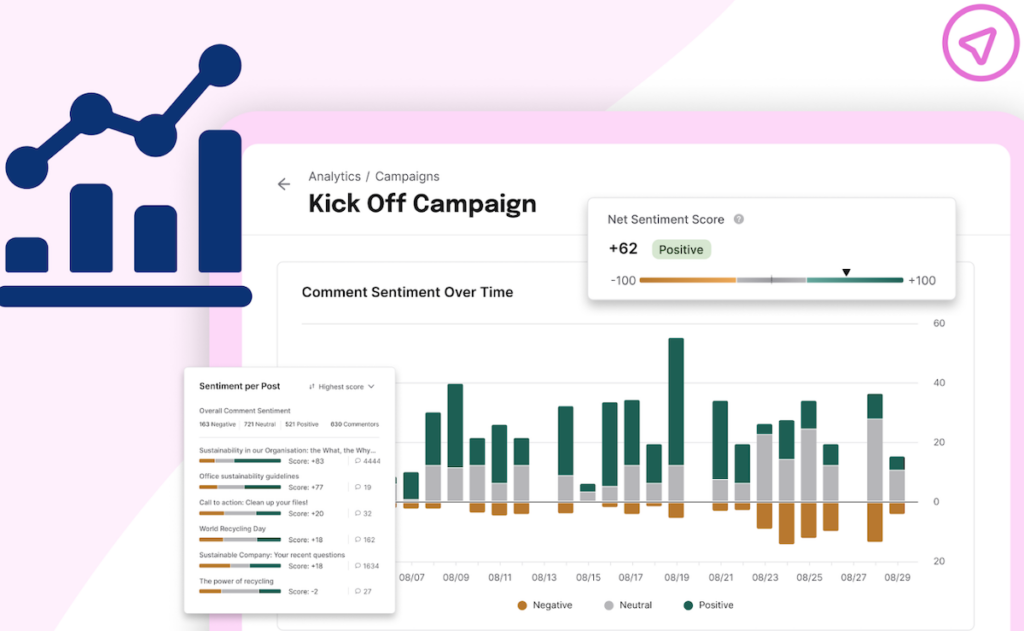Did you know that while many organizations invest heavily in internal communication tools, a significant portion of employees still feel disconnected or disengaged? Studies show that businesses with strong internal communication practices are 50% more likely to report higher levels of employee engagement. Yet, for many, the challenge lies in knowing what works and what doesn’t.
Traditional intranets often fall short in delivering the actionable insights needed to improve engagement and productivity. Without clear data on how employees interact with the platform, organizations are left guessing about its effectiveness. This lack of visibility makes it difficult to identify gaps, optimize content, or measure the success of communication strategies.
This is where intranet analytics enter the picture. By tracking metrics like user activity, content engagement, and employee satisfaction, organizations can gain a deeper understanding of how their intranet contributes to business goals. Beyond just numbers, analytics provide the context needed to make smarter decisions, foster better communication, and create a more connected workplace.
In this article, we’ll explore the fundamentals of intranet analytics, the key metrics every organization should track, and how data-driven insights can transform internal communications for the better.
What are intranet analytics?
Intranet analytics is the process of measuring and analyzing data related to the usage and performance of an organization’s intranet. By tracking key metrics such as page views, active users, and content engagement, intranet analytics provides valuable insights into how employees interact with the platform and how well it meets their needs.
The purpose of intranet analytics goes beyond simply gathering numbers — it’s about creating a more successful intranet experience. A well-analyzed intranet can significantly improve employee engagement by identifying which resources, tools, and content resonate most with users. It can also help optimize internal communication strategies. It lets you pinpoint areas where messages are missed or misunderstood. Ultimately, you can be ensured that critical information reaches the right people at the right time.

Moreover, intranet analytics enables organizations to measure the return on investment (ROI) of their internal communications efforts. By demonstrating the impact of specific campaigns or initiatives, it allows teams to align their strategies with broader business goals and prove the value of their work.
Ultimately, a data-driven approach to intranet management ensures a better user experience. It supports informed decision-making, and lays the foundation for a more connected and productive workforce. In today’s digital workplace, tracking the numbers is no longer optional — it’s essential for success. Let’s look at the reasons why.
Why are intranet analytics essential for business success?
Intranet analytics plays a pivotal role in driving business success. It provides the insights necessary to improve employee engagement, measure ROI, and align communication strategies with organizational objectives. Here’s how:
Understanding employee engagement
Engaged employees are the backbone of a successful organization. Intranet analytics helps you understand how your workforce interacts with internal platforms. By tracking metrics such as page views, average time spent on content, and user engagement with specific resources, you can identify what resonates with employees and what falls flat. For instance, if a particular announcement garners high engagement while another is largely ignored, you gain actionable feedback to refine your communication strategies.
With these insights, you can tailor your intranet design to meet the unique needs of your workforce. Doing so will foster a stronger connection between employees and the organization.
Proving ROI in communication efforts
Investing in internal communications tools is only worthwhile if you can demonstrate their impact. Intranet analytics enables you to align intranet goals with broader business objectives. You can track measurable outcomes such as improved productivity, reduced information silos, or faster onboarding processes.
For example, analytics can reveal how access to critical resources through the intranet has streamlined workflows or how a targeted campaign has boosted employee engagement. These data points empower teams to showcase the tangible benefits of their efforts, building a stronger case for continued investment.
Gallup Research: Organizations with top engagement scores experience 23% more profitability and 18% higher sales productivity.
Aligning messages with organizational goals
Effective communication is not just about delivering information — it’s about ensuring that information aligns with and supports the organization’s goals. Intranet analytics tools help identify gaps in messaging. Such gaps include departments or employee groups that are less engaged with certain content.
By analyzing these patterns, organizations can adapt their communication strategies to bridge these gaps, ensure consistent messaging across teams, and reinforce key objectives. This alignment between communication and goals not only enhances business outcomes but also strengthens employees’ connection to the company’s mission.
Intranet analytics isn’t just a technical tool. It’s a strategic asset that empowers businesses to engage employees, prove the value of their communications, and ensure alignment with their larger goals. It’s the key to transforming internal communications into a driver of organizational success.
The most important metrics to track in intranet analytics
Tracking the right metrics is crucial for leveraging intranet analytics effectively. These metrics provide insights into how employees engage with the intranet, collaborate with colleagues, and derive value from its resources. Here are the most important categories of metrics to monitor:
Engagement metrics
When you can measure employee engagement, you’ll be privy to a host of engagement metrics that tell you how actively employees interact with your intranet and provide a clear picture of its overall usage. Basic key metrics include:
- Page views: Monitor the number of visits to specific pages to identify popular or underutilized content.
- Active users vs. registered users: Compare the number of employees who regularly engage with the intranet against those who are simply registered but inactive.
- Time spent per session: Assess how long employees stay on the intranet to gauge whether they find it engaging and useful.
These metrics help organizations determine whether employees are effectively using the intranet and where improvements may be needed.
Collaboration metrics
An effective intranet fosters collaboration by encouraging employees to share ideas and work together. Collaboration metrics include:
- Contributions: Track employee actions such as posting updates, commenting, or liking content to measure active participation.
- Interdepartmental interactions: Monitor communication and collaboration between teams or departments to evaluate how well the intranet bridges silos.
These metrics highlight how well the intranet supports teamwork and fosters a culture of collaboration.
Content performance metrics
Understanding which content resonates with employees is key to optimizing your intranet. Important content performance metrics include:
- Most viewed/downloaded documents: Identify the resources employees find most valuable.
- Heatmaps for intranet clicks: Visualize where users are clicking most frequently to determine which areas of the intranet attract the most attention.
By analyzing these metrics, organizations can refine their content strategy to better meet employee needs.
Employee satisfaction metrics
A successful intranet enhances employee satisfaction by providing a user-friendly, resource-rich experience. Metrics in this category include:
- Results from surveys or polls: Use integrated tools to gather feedback on how employees perceive the intranet features as well as the overall experience it provides.
By combining employee feedback with engagement data, organizations can create a more user-centered intranet experience.
Tracking these metrics not only provides valuable insights into your intranet’s performance but also helps you make data-driven decisions to improve engagement, collaboration, and employee satisfaction. Together, these insights ensure your intranet continues to serve as a powerful tool for internal communication and organizational success.
Challenges in measuring communication impact
While intranet analytics offers significant potential to improve internal communications, organizations often encounter challenges in extracting actionable insights and connecting metrics to meaningful outcomes. Here are some of the most common obstacles:
Extracting meaningful insights
The sheer volume of data generated by intranet platforms can make it difficult to identify actionable trends. With numerous metrics available — ranging from page views to time spent per session — teams may struggle to pinpoint which data truly reflects employee engagement and communication effectiveness. Without a clear framework for analysis, critical insights may remain buried in the noise, leaving communicators unsure of how to act.
Connecting analytics to business outcomes
A major challenge in measuring communication impact lies in demonstrating how engagement metrics translate to tangible business outcomes. For instance:
• How does a spike in page views contribute to increased productivity?
• Does higher engagement with a specific piece of content correlate with improved alignment on business goals?
This gap between employee interaction data and business results can make it difficult to prove the ROI of internal communication efforts, leading to underinvestment in tools and strategies that could otherwise drive significant value.
Limitations of traditional tools
Traditional intranet analytics tools often fall short in delivering the depth of insights organizations need. Common limitations include:
- Lack of real-time insights: Without real-time data, teams may miss opportunities to address issues or capitalize on trends as they arise.
- Inability to measure sentiment or nuanced engagement: Metrics like page views and clicks provide surface-level information but fail to capture employee sentiment or deeper behavioral patterns, such as how content makes employees feel or how well messages align with their needs.
These shortcomings hinder organizations from fully understanding the effectiveness of their communication strategies.
Overcoming these challenges requires modern tools and frameworks that go beyond traditional analytics to provide actionable insights, connect metrics to outcomes, and offer real-time, nuanced data. Addressing these obstacles empowers organizations to make better decisions, drive engagement, and create an internal communication strategy that truly supports business success.
Introducing Staffbase Smart Impact: A game-changer in intranet analytics

In the realm of internal communications, understanding the true impact of your efforts is crucial. Staffbase Smart Impact is an advanced analytics tool designed to provide communicators with deep insights into the effectiveness of their strategies, enabling data-driven decisions that enhance employee engagement and align with organizational goals.
What is Staffbase Smart Impact?
Staffbase Smart Impact is a comprehensive analytics solution integrated within the Staffbase platform. It empowers internal communication teams to move beyond basic output metrics, offering a clear view of how their communications resonate with employees. By measuring visibility, engagement, sentiment, and alignment, Smart Impact helps organizations transform their communication strategies into drivers of real business outcomes.

Key features of Smart Impact
- Real-time analytics dashboards: Gain immediate access to data on how employees interact with your communications, allowing for timely adjustments and improvements.
- Sentiment analysis and employee survey integration: Understand employee reactions and feelings towards specific messages through integrated sentiment analysis and alignment surveys, providing a nuanced view of engagement.
- Targeted communication insights: Analyze content performance across different departments or employee groups to tailor messages more effectively and ensure they reach the intended audience.
- Multi-language support for global teams: Accommodate diverse workforces with analytics capabilities that support multiple languages, ensuring inclusivity in communication strategies.
Benefits of using Smart Impact for your organization
- Actionable insights for smarter decision-making: Leverage detailed analytics to inform your communication strategies, making them more effective and aligned with employee needs.
- Prove the ROI of internal communications efforts: Demonstrate the tangible impact of your communications on business objectives, justifying investments and guiding future initiatives.
- Optimize communication strategies based on real-time data: Adjust your approaches promptly in response to real-time feedback, ensuring that your communications remain relevant and impactful.
Success stories
Organizations utilizing Staffbase Smart Impact have reported significant improvements in their internal communications. For example, one company was able to reduce intranet content bounce rates by 30% after identifying and addressing content that was not engaging employees effectively. By focusing on the metrics provided by Smart Impact, companies can tailor their content to better meet employee interests and needs, resulting in increased engagement and productivity.
In short, Staffbase Smart Impact offers a robust suite of features that enable organizations to measure, analyze, and enhance their internal communications. By providing real-time, actionable insights, it serves as a vital tool for any organization aiming to foster a more engaged and aligned workforce.
How to get started with intranet analytics
Implementing intranet analytics might seem daunting, but with a clear plan and the right tools, it becomes a powerful strategy to improve internal communications and employee engagement. Here’s how to get started:
Set clear communication objectives
Before diving into data, define what success looks like for your intranet. What goals are you trying to achieve? These might include:
- Increasing employee engagement.
- Improving content accessibility and usability.
- Aligning communication efforts with organizational goals.
Clearly articulated objectives serve as the foundation for measuring progress and determining which metrics to prioritize. For example, if your goal is to enhance employee engagement, you might focus on metrics like page views, time spent on key content, and participation in surveys or polls.
IBM’s “Social Pulse” Program: IBM implemented a program that analyzed social data to understand employee sentiments in real-time, resulting in a 20% increase in employee engagement scores.
Leverage tools like Staffbase Smart Impact
Advanced analytics tools like Staffbase Smart Impact make it easier to track and interpret your intranet’s performance. To maximize the value of these tools:
- Familiarize yourself with the dashboards and features, such as real-time insights, sentiment analysis, and targeted communication metrics.
- Use these capabilities to identify trends, uncover engagement gaps, and refine your communication strategies.
Smart Impact not only simplifies the process of data collection but also provides actionable insights, empowering you to make informed decisions.
Continuously iterate and improve
Analytics is not a one-and-done process. To maintain an effective intranet:
- Act on the insights provided by your analytics tools. For instance, if you notice low engagement with a specific type of content, adjust your strategy to better meet employee needs.
- Regularly update your objectives and refine your metrics as your organization evolves.
- Conduct periodic reviews to ensure your intranet remains aligned with business goals and meets the expectations of your workforce.
By setting clear goals, utilizing advanced tools, and maintaining a commitment to improvement, you can transform your intranet into a valuable asset that drives engagement, enhances communication, and delivers measurable business results.
Learn more about Smart Impact and elevate your intranet strategy with smart insights
Intranet analytics has the power to transform how organizations engage their employees, align communication strategies, and drive business outcomes. Staffbase Smart Impact takes this potential to the next level by offering advanced tools that provide real-time insights, targeted metrics, and actionable data to optimize your intranet’s performance.
Whether you’re aiming to measure ROI, track engagement trends, or fine-tune your communication strategies, Smart Impact equips you with the information you need to make smarter, data-driven decisions. Its intuitive dashboards, sentiment analysis, and ability to deliver insights by department or demographic make it a must-have for modern intranet management.
Ready to see how Staffbase Smart Impact can revolutionize your intranet strategy?
📅 Book a demo today to explore the full capabilities of this cutting-edge analytics tool. You’ll discover how it can help your organization achieve measurable success in internal communications.
Transform your intranet with smart analytics
In today’s fast-paced workplace, internal communications play a crucial role in connecting employees, driving engagement, and supporting organizational goals. Intranet analytics provides the insights needed to make your communications not just effective, but transformative.
With Staffbase Smart Impact, tracking these insights has never been easier. By offering real-time analytics, sentiment tracking, and actionable data, Smart Impact simplifies the process of turning metrics into measurable success. Whether it’s boosting engagement, improving alignment, or proving ROI, Smart Impact is your partner in creating a smarter, more impactful intranet.
Take the first step toward elevating your intranet strategy. Book a demo of the Staffbase Intranet today and unlock the full potential of your internal communications.







